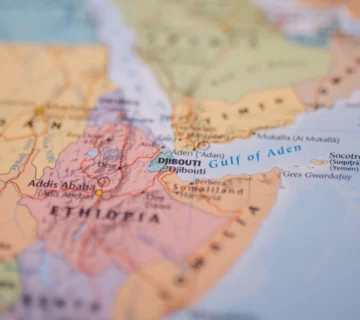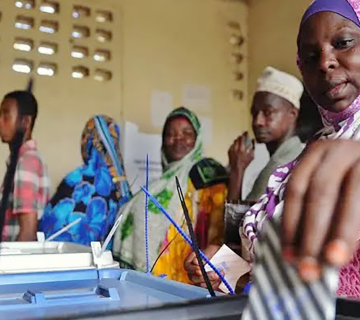With the escalation of the Tigray war in Ethiopia, the African Union (AU) is seeking to make its mark by mediating the ongoing conflict that is pushing Ethiopia to the brink of collapse. On Sunday, November 7, 2021, the AU High Representative for the Horn of Africa and Nigeria’s former President Olusegun Obasanjo met and held talks with the Tigray leader, Debretsion Gebremichael in Mekelle, in an effort to find a peaceful resolution to the crisis. The talks, which have been regarded by the Tigrayan leadership as being ‘very fruitful’ are a fresh, new development that can change the course of the Tigray war. The AU-Peace and Security Commission meeting on the situation in Ethiopia held on Monday, November 8, 2021, reaffirmed efforts by Obasanjo in seeking the cessation of hostilities and peaceful resolution of the conflict, pledging unwavering support to the mediation process. If fostered and robustly supported by regional and international stakeholders, the AU-led third-party mediation holds the potential to break the deadlock and put Ethiopia back on the path of peace and reconciliation.
Tigray War
Since November 2020, a military-turn-civil war has been ongoing in Ethiopia’s northern region of Tigray. The war started out as a security operation by the federal government against the Tigrayan forces allied to the defiant Tigray People’s Liberation Front (TPLF) for allegedly attacking the Ethiopian army command in Mekelle. On November 4, 2020, Prime Minister Abiy Ahmed deployed the Ethiopian National Defence Forces (ENDF) troops to the Tigray region and after weeks of intense fighting against Tigrayan Defence Forces (TDF), the federal government announced victory and subsequently removed the TPLF administration from power. However, the war did not stop. Instead, it morphed into guerrilla warfare as TDF and Tigrayan leaders regrouped and re-emerged as a lethal insurgent force. Within a few months, the insurgency pushed out combined Ethiopia-Eritrean troops and Amhara paramilitary forces from Mekelle and has since made serious incursions into Afar and Amhara regions, pushing southwards to the capital, Addis Ababa.
The war has caused a humanitarian disaster in Ethiopia. Thousands of Ethiopians have so far lost their lives and several hundreds of thousands have been rendered homeless. According to conservative reports, about 5.2 million people in northern Ethiopia face hunger, disease and other humanly degrading conditions. Further, a joint investigation report by the Ethiopian Human Rights Commission and the Office of the United Nations High Commissioner on Human Rights, found all parties to the war responsible for serious abuses and violations of human rights, humanitarian and refugee law, amounting to war crimes and crimes against humanity. These include arbitrary killings, forced disappearances, illegal arrests and detention, sexual violence, and other war atrocities including torture and massacres.
The year-long war is also derailing both political and socio-economic development in Ethiopia. Besides high commodity prices, disrupted business, looting and property destruction, Ethiopia is suffering significant financial losses as foreign donors withdraw their financial assistance. On the regional hand, there are fears about the internationalization of the war. Already, Eritrean forces have been engaging in war and there are fears that as the war spreads, both Sudan and Djibouti might be implicated as the fighting reaches their borders. In addition, the war exacerbates the humanitarian and refugee crisis in the Horn of Africa, as thousands of displaced persons seek asylum in neighboring countries. Further, the war adds to the Horn of Africa’s security challenges and aggravates regional instability.
Africa Union’s Mediation
In the current environment, there is no doubt that military victory will not be possible for either side in the foreseeable future. Only a credible third-party mediation process, in which positions are carefully negotiated, can put Ethiopia back on the path of peace. The AU has kickstarted that process, with the deployment of Olusegun Olusegun to do the groundwork and understand the issues on both sides. Reportedly, both Prime Minister Abiy and TPLF leader Gebretsion Gebremichael have accorded Obasanjo a listening ear, hinting at a possibility of dialogue. However, as the AU plans to engage in a robust mediation process, the following three considerations should be made, if sustainable peace is to be achieved.
First, the AU should encourage a coordinated mediation effort where other stakeholders including the US, UN and the EU back the efforts by the AU, at least covertly, given the growing negative perception of the western partners, particularly the US among pro-government Ethiopians. Regional actors such as Kenya through President Uhuru Kenyatta must work to reinforce the efforts by the AU High Representative. A coordinated diplomatic strategy is likely to lend credibility and bolster AU’s capacity, thereby helping in closing the tactical gaps that have a decisive action by the AU. As splitting mediation efforts risks raising divisions, forum shopping and eventual failure, empowering a credible regional figure in the person of Obasanjo could prove the only key to success in bringing parties from both sides to a negotiating table.
Second, Obasanjo must press the federal government and the Tigray leadership to declare a cessation of hostilities and withdraw their troops from fighting zones. This must then be followed by pressing the parties to make concessions that will allow a unified process towards peace. Particularly, Tigray leaders should withdraw their military from Amhara and Afar regions with the federal government also stopping arbitrary targeting of Tigrayans in the implementation of state of emergency regulations and further lifting restrictions on humanitarian access to the Tigray region. Further, Amhara forces should withdraw from the western Tigray region.
Third, recognizing the uniqueness of the Tigray war and achieving a careful balance of interests between the parties, will be important in driving toward consensus and deal-breaking. The AU mediation process should thus be supported by continuous needs assessment to determine changes in priorities and positions, and align negotiations as appropriate.
Otieno O. Joel is a Researcher at the HORN Institute
Photo: Delegates at a past African Union (AU) Summit at the AU headquarters in Addis Ababa, Ethiopia (Photo Credit: AP Photo)
The contents of this article are copyright of © The HORN Institute 2022. All rights reserved. Any redistribution or reproduction of part or all of the contents in any form and for whatever reason is prohibited. You may use the content of this article for personal reasons, but acknowledge the website as the source of the material.



